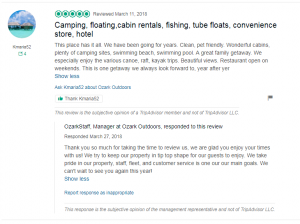
Your business can add credibility and complexity to its content when you regularly incorporate the positive feedback your customers leave. This practice has an added bonus of rewarding customers for their praise, strengthening your relationship with them and encouraging others to follow in their footsteps.
You may think that simply regurgitating customer acclaim can seem like a cheap or shallow tactic. When you go about using customer reviews incorrectly, that can absolutely be the case.
But when you can masterfully weave praise into your content marketing and collateral materials, it feels like a natural fit. Your content becomes richer, and your brand name becomes more credible.
According to eMarketer research, online reviews are by far the most trusted source of business information. In fact, 8 percent more people 18+ trust online reviews compared to their own friends, family and colleagues. Putting your reviews front and center in your content offers documented proof of peer approval, and no one has to go digging into third-party sites to find that proof.
So if you’re considering using customer reviews to obtain all of the above benefits and more, try putting the following strategies into action.
Pepper Website Pages, and Especially Landing Pages, With Embedded Reviews and Accolades

Businesses have a huge trust gap they must clear when a potential customer or client first arrives at their website. No matter how comforting or flashy the site is, customers are always on the lookout for signs that they could get burned. They may scrutinize your claims or look for fine print that reveals how your offers aren’t what they seem.
Oftentimes, they will look to outside resources before they can let down their guard. A study by Nielsen and the Better Business Bureau unveiled that over half (55 percent) of all U.S. adults online “always” or “often” used ratings and reviews to inform their purchase decisions. The trend deepens among those under 55, where only 7.5 percent of people say they “rarely” or “never” look at reviews.
Incorporating reviews right there on your web page immediately begins to chip away at their defenses. They can feel a tinge of relief knowing explicitly that your business has rewarded others for their trust. Evidence that people don’t regret spending their hard-earned money on your products or services can reduce the natural hesitation some people might feel.
You also potentially negate their need to go hunting for outside information on your brand. If they already see positive reviews or a live meter documenting your score aggregate for a site like Yelp, then they don’t need to go wading into all of the other reviews online. By extension, they are much less likely to encounter negative reviews that color your business in an unfavorable light.
Even if someone does do their own homework and encounters a mixture of positive and negative reviews, their first impressions are already fairly rosy. Each negative reviewer must then make their case for why this positive first impression is wrong.
When incorporating testimonials and feedback on your web pages, be sure to use the following best practices:
- Take a second to re-read the third-party reviews site’s policy on sharing reviews. They may have limitations on how you use them.
- Always ask the reviewer for permission. Nothing hurts worse than having someone who praised your business turn around and complain that their own words were used unethically.
- Don’t take things out of context. Using an excerpt of a review is fine, but don’t cherry-pick statements that are actually out of color for the nature of the review as a whole. For instance, don’t take just the positive things someone conceded out a scathingly negative review.
- Quote the person verbatim. Changing words around or using tricks like mashing two unrelated things together to make a sentence is absolutely deceptive and unethical. You may even be subject to FTC penalties.
- Favor embedded reviews over text quotes. Most third-party sites actually demand that you use embedded features since these are more transparent. When you receive direct feedback, such as on a blog comment, try to embed the message itself when possible.
Share Interesting or Glowing Reviews to Social Media

Getting people to leave reviews is hard work! Unless, of course, they had a bad experience. According to one study of 2,000 U.S. consumers, over half of people say they’re likely to publicly complain about a bad experience with a business—often resulting in a bad review.
A second study found that most people only leave a positive review if they were overwhelmed with how great their experience was. “If instead you had a moderate view, you’re likely to have left no review at all, finding it not worth the time and effort,” say the researchers in the Harvard Business Review.
So how do you encourage people to leave a review if they aren’t angry with you and they weren’t absolutely blown away? Simple: reward them with a public mention!
By sharing someone’s positive review online, you reinforce the behavior. You also encourage others who want public recognition and attention to leave reviews of their own.
Again, follow the guidelines above. Certain platforms like Yelp forbid copying and pasting review text, for example. You also absolutely need to secure permission from the person before sharing, even if their praise was a public comment on one of your social media or blog posts.
Let Reviews Inspire Your Content Marketing Strategy
Content should solve audience needs and conclude with a gentle promotional nudge towards your company. Treading this narrow path between information and promotion is admittedly difficult for most businesses. Seventy-nine percent of editors say they have to turn down guest blog pitches because they’re overpromotional.
The problem is that most businesses can’t find an angle. “8 Reasons Our Food Is Amazing” is something no one would want to click on! But “10 Keys to Improving Customer Service” can work, especially if you’re able to point to specific best practices you can use.
When writing these types of articles, starting with positive features of your business or product as a jumping-off point can lead to a disconnect. In other words, your business could be proud of something that no one really notices.
Instead, take a look at your own reviews to get inspired. Take a look at this review below to see what we mean.

Here, you can see that the person cites six different positive reasons they love coming to the resort; it was clean, pet friendly, had great cabins, lots of site availability, a swimming beach and also a swimming pool.
Taking that list, you can simply write an article about the “6 Most Important Things to Look for in a Camping Resort.” Since you know people enjoy these things about your business, you can mention them honestly. You can also write while thinking about the perspective of a customer who has been to a campsite that is not clean or that regularly has overcrowded and overbooked sites.
Of course, you can also use negative criticism to inspire you. If you have had issues in the past with bad customer service, you can list “X Things We’ve Changed to Make Your Experience Better” to win people back.
Getting More Customer Reviews to Use in Your Content Marketing

All of the strategies listed above depend on a constant, fresh stream of customer feedback. If your most recent review was from 2014, you may have a problem!
To counteract this issue, make leaving a review as convenient as possible. You can use third-party software tools to automatically send an email to someone and ask them for their review on your preferred platform. You can also leave a convenient link on your home page so that everyone can easily find their way to your review pages.
Don’t just encourage people to go on sites like TripAdvisor or Yelp, either. You can ask for more detailed feedback in an email or through an online form submission. Reach out to some of your most loyal or satisfied guests to see if they would take the time to write a one to three paragraph testimonial on your behalf.
You can use these longer reviews (with their permission) as quotes or embedded reviews framing your content or occupying your most critical landing pages.
Another surefire method to jog people’s memory is to use marketing collateral offered by review platforms both online and in real life. Place window decals on your entrance, or include a ready-to-print plaque right by your cash register.
Train sales associates and customer-facing reps to ask for feedback at the end of every interaction. Be aware of specific platform policies, though. For instance, Yelp demands that you only use certain brand materials in certain ways. They also have a strict policy where you can’t ask people to “review our business on Yelp!”
With just a small amount of effort, your content quality and credibility can be dramatically improved by using customer reviews in clever ways. Customers’ trust absolutely thrives on documented proof, and they like to see that their words matter when they have something to say.
Sharing their reviews is the best way to tell them “thank you” and that their opinion is important. That’s customer service and content marketing rolled into one!
Leave a Reply
You must be logged in to post a comment.